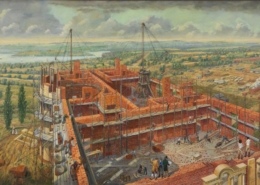Enhancing Water Management
With environmental stewardship a key aim of the Tudor Place Master Preservation Plan, sound water management becomes an essential goal. The museum will take a key step in that direction this summer with the expected installation of a cistern to conserve and control stormwater run-off. The project expands on past efforts to improve drainage around the historic house, with benefits extending as far as the Potomac watershed.
A decade ago, a new perimeter drainage system at the main house connected existing downspouts to drains installed in window areas. While this system successfully carried water away from the house, the resulting discharge on the South Lawn led to erosion and runoff. In 2016, an erosion-control intervention on the lawn’s southwest corner (using jute mesh, jute logs and silt fencing) temporarily mitigated the problem, but it’s a stopgap. The long-term solution is to install an underground cistern to capture the rainwater, treat it, and retain it for irrigation. On the rare occasions when runoff exceeds the cistern’s 21,000-gallon capacity, it will discharge through pipes directly into the city’s storm sewer system on 31st Street.
The full system will reduce erosion and runoff while also cutting our consumption of fresh water. We expect the work to happen in late summer 2017.
Sustainability at Tudor Place
 In addition to preserving a National Historic Landmark, Tudor Place strives to be a good neighbor and thoughtful member of the local and global communities. We are proud to advance a Master Preservation Plan that includes sustainability measures such as effective storm water management, the use of geothermal energy, installation of LED lighting, and other energy conservation activities.
In addition to preserving a National Historic Landmark, Tudor Place strives to be a good neighbor and thoughtful member of the local and global communities. We are proud to advance a Master Preservation Plan that includes sustainability measures such as effective storm water management, the use of geothermal energy, installation of LED lighting, and other energy conservation activities.








